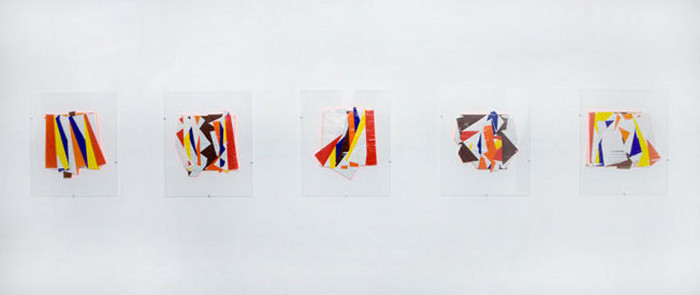Flurin Bisig
23 Oct - 20 Nov 2010
FLURIN BISIG
The First Rendez Vous
23 October - 20 November 2010
How do you prepare for the first rendez-vous? You want to make an unforgettable impression, and at the same time, you expect the other person to be every bit as special as you had hoped. Face to face with sculptures by the young Swiss artist Flurin Bisig (Samedan, Switzerland, 1982), Amsterdam’s gallery-goers may find his work enthralling – or who knows, even fall in love with it. Bisig invites our gazes to drift lovingly over the taut lines of his impressive spatial constructs, but at the same time he leads them astray in a labyrinth of paint traces, wooden blocks, and subtle, inconspicuous formal moves. The overall experience thus resembles a quest for an adventurous stability; behind their trashy details and neon colours, these sculptures conceal an almost classical visual drawing.
Through his art, Bisig aims to write a new chapter in the history of sculpture. While respecting the central principle of classical sculpture, the unity of the work, he throws himself into experimenting with contemporary sculptural idiom. His point of departure is always a specific, material reality – a piece of wire, wooden blocks, tables, improvised platforms, or planks of wood – which he transforms in an intuitive but highly concentrated manner, raising it to a more abstract level. His oeuvre is not a set of well-defined subjects, but a laboratory of ideas. Of course, he doesn’t leave everything to chance; his sculptures are more like experimental fields of conceptual and practical possibilities, in which every new work strives for a new dynamic and a logic of its own. In this context, the work often goes beyond the maker’s original intentions, entering into an unexpected dialogue with the surrounding space. Despite the wide diversity of the materials used, they all have one quality in common: their lightness. The emphasis on precisely this quality stems from Bisig’s desire to make objects that are easily portable. Each of his works is therefore somewhere between a representation, a model, and a simple, emphatic presence. It’s as if he’s trying to show us that the point is not the materials, but the possibilities.
According to Bisig, the essential insight of his work is that we don’t see objects and ideas as valuable or irreplaceable until they’re on the verge of disintegrating or disappearing forever. Unwilling to wait for that fateful moment, he incorporates the traces of mortality and decay into his work, echoing the words of Leonard Cohen:
Forget your perfect offering
There is a crack in everything
That’s how the light gets in.
[Marta Gnyp]
The First Rendez Vous
23 October - 20 November 2010
How do you prepare for the first rendez-vous? You want to make an unforgettable impression, and at the same time, you expect the other person to be every bit as special as you had hoped. Face to face with sculptures by the young Swiss artist Flurin Bisig (Samedan, Switzerland, 1982), Amsterdam’s gallery-goers may find his work enthralling – or who knows, even fall in love with it. Bisig invites our gazes to drift lovingly over the taut lines of his impressive spatial constructs, but at the same time he leads them astray in a labyrinth of paint traces, wooden blocks, and subtle, inconspicuous formal moves. The overall experience thus resembles a quest for an adventurous stability; behind their trashy details and neon colours, these sculptures conceal an almost classical visual drawing.
Through his art, Bisig aims to write a new chapter in the history of sculpture. While respecting the central principle of classical sculpture, the unity of the work, he throws himself into experimenting with contemporary sculptural idiom. His point of departure is always a specific, material reality – a piece of wire, wooden blocks, tables, improvised platforms, or planks of wood – which he transforms in an intuitive but highly concentrated manner, raising it to a more abstract level. His oeuvre is not a set of well-defined subjects, but a laboratory of ideas. Of course, he doesn’t leave everything to chance; his sculptures are more like experimental fields of conceptual and practical possibilities, in which every new work strives for a new dynamic and a logic of its own. In this context, the work often goes beyond the maker’s original intentions, entering into an unexpected dialogue with the surrounding space. Despite the wide diversity of the materials used, they all have one quality in common: their lightness. The emphasis on precisely this quality stems from Bisig’s desire to make objects that are easily portable. Each of his works is therefore somewhere between a representation, a model, and a simple, emphatic presence. It’s as if he’s trying to show us that the point is not the materials, but the possibilities.
According to Bisig, the essential insight of his work is that we don’t see objects and ideas as valuable or irreplaceable until they’re on the verge of disintegrating or disappearing forever. Unwilling to wait for that fateful moment, he incorporates the traces of mortality and decay into his work, echoing the words of Leonard Cohen:
Forget your perfect offering
There is a crack in everything
That’s how the light gets in.
[Marta Gnyp]

